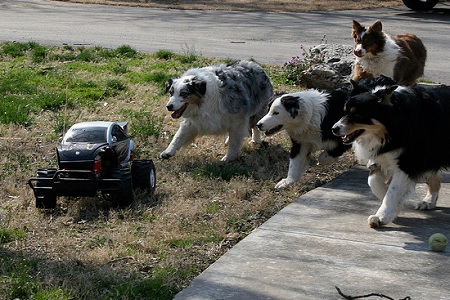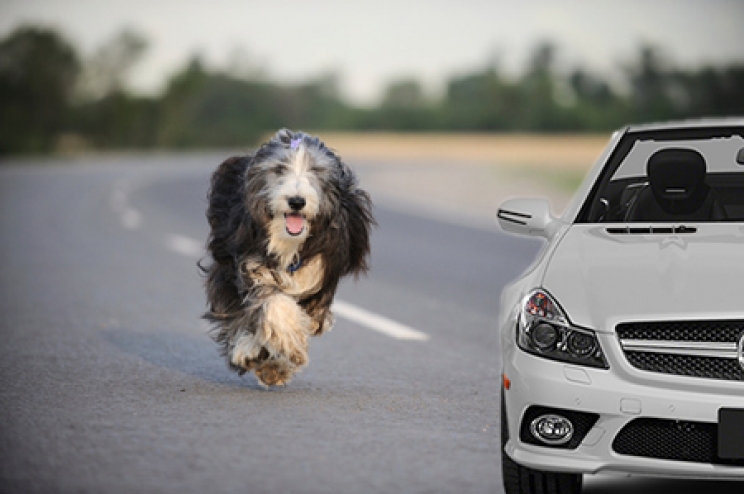There are many dogs that tend to be particularly attracted to anything that moves quickly. This aspect itself is not negative, on the contrary, throwing balls and frisbees in the open air must be part of their daily game moment. The real problem occurs when the dog starts barking or chasing cars and motorbikes, putting his own safety and that of the owner at risk, who perhaps cannot keep the leash due to the strong pull. What can be the causes of this behaviour and what can we do to avoid it?
Why does the dog chase cars and motorbikes?
The answer to this question actually requires some very important distinctions depending on the breed of the dog.
Some dog breeds, such as Border Collies and Australian Shepherds, were used in the past and still today because of their great aptitude for leading the herd to pasture. How do they manage to gather a rather large number of sheep? They run at high speed to prevent some animals from escaping the rest of the group.
The attitude of the dog is a concept that unfortunately is not always considered at the time of adoption. In fact, many families choose their future four-legged friend regardless of what their natural attitude is. A dog that by nature is inclined to run and lead will naturally need to put this characteristic into practice. The risk is that it may direct it towards other improper or dangerous animals or objects, such as cars and motorbikes racing down the street.

Another case could be represented by all those dogs who never had the opportunity to find out what is on the other side of the fence at home. They constantly hear the noise of cars passing at high speed, but unfortunately they have no way of seeing what it is. What happens in these cases? The same thing that happens to us every time we discover something new. We are intrigued or afraid of it. Well, when the dog sees the cars for the first time, he probably feels intimidated by this loud noise and by the great speed with which it crosses the road, so he could react by running away for fear or trying to chase and attack them.
We also refer to dogs who feel frustrated in general, regardless of its breed and attitude. All animals have a great need to run, play and have fun, in order to discharge all the energy they accumulate during the day. If the owner is unable to satisfy this fundamental need, the animal will accumulate energy, which remains repressed, generating a sense of boredom, and frustration, which in the long run turns into stress, with the related psychophysical consequences. This can greatly affect the mental balance of the dog, which can begin to implement inappropriate behaviours.
What should I do?
A problem of this type requires demanding work, which must necessarily take into account the underlying cause of everything. So, before starting, let's try to understand which of the cases listed above can best reflect our dog.
If the problem "simply" concerns boredom, we will have to give the dog a way to use all his energy in something fun and creative. Let's make sure that he can spend at least 30 minutes a day away from home, without walking long distances and without interacting with him.
Playing in the right way with the dog is also essential. In fact, the game helps to channel its predatory instinct into a much safer activity than chasing cars. Let's make sure to do it often at home, choosing games such as the carryover or activities that stimulate his patience, such as an effective toy filled with food or intelligence tables.
All this will have to be done to maintain the right mental and physical balance in the dog, but we must also intervene when we taking a walk away from home and the object of his desires is within his reach. Here is what we can do:
- We use a sturdy leash, holding it firmly;
- Do not leave the dog free, unless it is a completely isolated place from cars and motorcycles;
- Practice the commands such as "sit" and "still", which he must already know very well;
- Whenever we perceive the noise of the car, we try to distract him with the game;
- When the car is about to pass, we put the "sit" or "stop" command into practice. Whenever he executes the command, we can reward him with his favourite snack;
- If he cannot ignore the car besides our intents, we could continue to distract him by playing or by attracting his attention in a fun way, to make him understand that it is better to interact with us than to chase cars
Finally, another effective tip may be to strengthen self-confidence by making him discover the world. This should always be done in complete safety for us and for the dog, starting right from the car. Do you get in the car often enough? Do we take him with us even for short trips? We can begin to do it, perhaps following the indications given in this useful guide.










